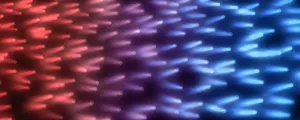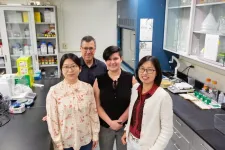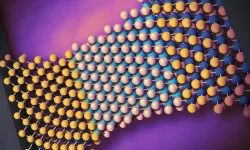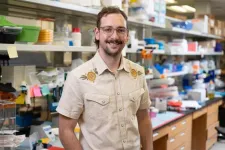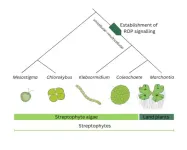(Press-News.org) Long before researchers discovered the electron and its role in generating electrical current, they knew about electricity and were exploring its potential. One thing they learned early on was that metals were great conductors of both electricity and heat.
And in 1853, two scientists showed that those two admirable properties of metals were somehow related: At any given temperature, the ratio of electronic conductivity to thermal conductivity was roughly the same in any metal they tested. This so-called Wiedemann-Franz law has held ever since – except in quantum materials, where electrons stop behaving as individual particles and glom together into a sort of electron soup. Experimental measurements have indicated that the 170-year-old law breaks down in these quantum materials, and by quite a bit.
Now, a theoretical argument put forth by physicists at the Department of Energy’s SLAC National Accelerator Laboratory, Stanford University and the University of Illinois suggests that the law should, in fact, approximately hold for one type of quantum material – the copper oxide superconductors, or cuprates, which conduct electricity with no loss at relatively high temperatures.
In a paper published in Science today, they propose that the Wiedemann-Franz law should still roughly hold if one considers only the electrons in cuprates. They suggest that other factors, such as vibrations in the material’s atomic latticework, must account for experimental results that make it look like the law does not apply.
This surprising result is important to understanding unconventional superconductors and other quantum materials, said Wen Wang, lead author of the paper and a PhD student with the Stanford Institute for Materials and Energy Sciences (SIMES) at SLAC.
“The original law was developed for materials where electrons interact with each other weakly and behave like little balls that bounce off defects in the material’s lattice,” Wang said. “We wanted to test the law theoretically in systems where neither of these things was true.”
Peeling a quantum onion
Superconducting materials, which carry electric current without resistance, were discovered in 1911. But they operated at such extremely low temperatures that their usefulness was quite limited.
That changed in 1986, when the first family of so-called high-temperature or unconventional superconductors – the cuprates – was discovered. Although cuprates still require extremely cold conditions to work their magic, their discovery raised hopes that superconductors could someday work at much closer to room temperature – making revolutionary technologies like no-loss power lines possible.
After nearly four decades of research, that goal is still elusive, although a lot of progress has been made in understanding the conditions in which superconducting states flip in and out of existence.
Theoretical studies, performed with the help of powerful supercomputers, have been essential for interpreting the results of experiments on these materials and for understanding and predicting phenomena that are out of experimental reach.
For this study, the SIMES team ran simulations based on what’s known as the Hubbard model, which has become an essential tool for simulating and describing systems where electrons stop acting independently and join forces to produce unexpected phenomena.
The results show that when you only take electron transport into account, the ratio of electronic conductivity to thermal conductivity approaches what the Wiedemann-Franz law predicts, Wang said. “So, the discrepancies that have been seen in experiments should be coming from other things like phonons, or lattice vibrations, that are not in the Hubbard model,” she said.
SIMES staff scientist and paper co-author Brian Moritz said that although the study did not investigate how vibrations cause the discrepancies, “somehow the system still knows that there is this correspondence between charge and heat transport amongst the electrons. That was the most surprising result.”
From here, he added, “maybe we can peel the onion to understand a little bit more.”
Major funding for this study came from the DOE Office of Science. Computational work was carried out at Stanford University and on resources of the National Energy Research Scientific Computing Center, which is a DOE Office of Science user facility.
Citation: Wen O. Wang et al., Science, 01 December 2023 (10.1126/science.ade3232)
SLAC is a vibrant multiprogram laboratory that explores how the universe works at the biggest, smallest and fastest scales and invents powerful tools used by scientists around the globe. With research spanning particle physics, astrophysics and cosmology, materials, chemistry, bio- and energy sciences and scientific computing, we help solve real-world problems and advance the interests of the nation.
SLAC is operated by Stanford University for the U.S. Department of Energy’s Office of Science. The Office of Science is the single largest supporter of basic research in the physical sciences in the United States and is working to address some of the most pressing challenges of our time.
END
Researchers show an old law still holds for quirky quantum materials
This surprising result is important for understanding unconventional superconductors and other materials where electrons band together to act collectively.
2023-11-30
ELSE PRESS RELEASES FROM THIS DATE:
Pickier dogs have pickier brains
2023-11-30
Dogs’ food preferences are mirrored in their brain activity, particularly within their caudate nuclei -a brain region associated with reward processing, a new study combining behavioural and neuroimaging data by researchers from the Department of Ethology, Eötvös Loránd University (Hungary) and Symrise Pet Food (France) finds. The study, which seamlessly blends behavioral observations with advanced neuroimaging techniques, offers novel insights into the influence of food quality on dogs' motivation. This work has been published in Scientific Reports.
Similar to people, ...
Despite pressures facing young families, parents take precious moments to play with their babies
2023-11-30
Four in five primary caregivers of nine-month-old babies reported cuddling, talking and playing with their little one several times a day, in England's first national long-term study of babies in over two decades, led by UCL (University College London).
More than half engaged in physical or turn-taking play, singing, pretend games and noisy play with their babies several times a day – activities which were linked to improved early language development. Around three quarters showed their babies picture ...
Combined use of alcohol and THC can affect rat brains, study finds
2023-11-30
The increased legalization of cannabis over the past several years can potentially increase its co-use with alcohol. Concerningly, very few studies have looked at the effects of these two drugs when used in combination. In a series of new studies, researchers at the University of Illinois Urbana-Champaign used rats to understand how brain structure and behavior can change when cannabis and alcohol are taken together.
Most researchers have studied the effects of either alcohol or THC (delta-9-tetrahydrocannabinol), the primary psychoactive drug in cannabis, alone. However, when people, especially adolescents, use these drugs, ...
Tis the season to recognize chocolate: researchers highlight high quality cacao in Colombia
2023-11-30
Scientists are working to protect the unique qualities of cacao beans grown in the Buenaventura region on the Pacific coast of Colombia.
In a study published in the Journal of the Science of Food and Agriculture, researchers from the Colombian Corporation for Agricultural Research (AGROSAVIA) have examined a wealth of metrics to uncover the complex interactions between environmental factors and cacao quality.
In a pioneering move, they have proposed that Buenaventura should be designated as a new Denomination of Origin (DO) for cacao trees. This is a legal recognition given to products that originate ...
Straining memory leads to new computing possibilities
2023-11-30
By strategically straining materials that are as thin as a single layer of atoms, University of Rochester scientists have developed a new form of computing memory that is at once fast, dense, and low-power. The researchers outline their new hybrid resistive switches in a study published in Nature Electronics.
Developed in the lab of Stephen M. Wu, an assistant professor of electrical and computer engineering and of physics, the approach marries the best qualities of two existing forms of resistive switches used for memory: memristors and phase-change materials. Both forms have been explored for their advantages over ...
Antarctica's ancient ice sheets foreshadow dynamic changes in Earth’s future
2023-11-30
MADISON – Nineteen million years ago, during a time known as the early Miocene, massive ice sheets in Antarctica rapidly and repeatedly grew and receded. The Miocene is widely considered a potential analog for Earth's climate in the coming century, should humanity remain on its current carbon emissions trajectory.
Identifying how and why Antarctica's major ice sheets behaved the way they did in the early Miocene could help inform understanding of the sheets' behavior under a warming climate. Together, the ice sheets lock a volume of water equivalent to more than 50 meters of sea level rise and influence ocean currents that affect marine food webs and regional climates. ...
Modular chimeric cytokine receptors improve CAR T–cell therapy for solid tumors
2023-11-30
(MEMPHIS, Tenn. – November 30, 2023) Immunotherapy using modified chimeric antigen receptor (CAR) T cells has greatly improved survival rates for pediatric patients with relapsed and recurrent leukemia. However, these therapies are not as effective in treating solid tumors and can have significant toxicity. Findings from St. Jude Children’s Research Hospital showed that adding a modular chimeric cytokine receptor to CAR T cells increased their efficacy in multiple solid tumor models. The study was published today in Nature Biomedical Engineering.
“We designed modular chimeric cytokine receptors and showed that ...
Climate: why disinformation is so persistent
2023-11-30
Melting of glaciers, rising sea levels, extreme heat waves: the consequences of climate change are more visible than ever, and the scientific community has confirmed that humans are responsible. Yet studies show that a third of the population still doubts or disputes these facts. The cause is disinformation spread by certain vested interests. To try and prevent this phenomenon, a team from the University of Geneva (UNIGE) has developed and tested six psychological interventions on nearly 7,000 participants from twelve countries. The research, published in ...
Early body contact develops premature babies' social skills
2023-11-30
Skin-to-skin contact between parent and infant during the first hours after a very premature birth helps develop the child's social skills. This is according to a new study published in JAMA Network Open by researchers from Karolinska Institutet and others. The study also shows that fathers may play a more important role than previous research has shown.
In current practice, very premature babies are usually placed in an incubator to keep them warm and to stabilize them during the first hours after birth. In the “Immediate parent-infant skin-to-skin study” (IPISTOSS), 91 premature babies born at 28 to 33 weeks were randomized to either ...
ROP signaling: Origin at dawn of multicellular plant life
2023-11-30
Plants regulate their development with a distinct group of molecular players. ROP proteins, a group of plant-specific proteins, are known to control plant tissue formation. Now, Hugh Mulvey and Liam Dolan at the GMI show that ROP proteins evolved at the transition between unicellular and multicellular plant life. The findings are published on November 30 in the journal Current Biology.
Being non-mobile, plants follow a very different lifestyle from us animals. To grow and develop, plants also need a distinct ...
LAST 30 PRESS RELEASES:
Injectable breast ‘implant’ offers alternative to traditional surgeries
Neuroscientists devise formulas to measure multilingualism
New prostate cancer trial seeks to reduce toxicity without sacrificing efficacy
Geometry shapes life
A CRISPR screen reveals many previously unrecognized genes required for brain development and a new neurodevelopmental disorder
Hot flush treatment has anti-breast cancer activity, study finds
Securing AI systems against growing cybersecurity threats
Longest observation of an active solar region
Why nail-biting, procrastination and other self-sabotaging behaviors are rooted in survival instincts
Regional variations in mechanical properties of porcine leptomeninges
Artificial empathy in therapy and healthcare: advancements in interpersonal interaction technologies
Why some brains switch gears more efficiently than others
UVA’s Jundong Li wins ICDM’S 2025 Tao Li Award for data mining, machine learning
UVA’s low-power, high-performance computer power player Mircea Stan earns National Academy of Inventors fellowship
Not playing by the rules: USU researcher explores filamentous algae dynamics in rivers
Do our body clocks influence our risk of dementia?
Anthropologists offer new evidence of bipedalism in long-debated fossil discovery
Safer receipt paper from wood
Dosage-sensitive genes suggest no whole-genome duplications in ancestral angiosperm
First ancient human herpesvirus genomes document their deep history with humans
Why Some Bacteria Survive Antibiotics and How to Stop Them - New study reveals that bacteria can survive antibiotic treatment through two fundamentally different “shutdown modes”
UCLA study links scar healing to dangerous placenta condition
CHANGE-seq-BE finds off-target changes in the genome from base editors
The Journal of Nuclear Medicine Ahead-of-Print Tip Sheet: January 2, 2026
Delayed or absent first dose of measles, mumps, and rubella vaccination
Trends in US preterm birth rates by household income and race and ethnicity
Study identifies potential biomarker linked to progression and brain inflammation in multiple sclerosis
Many mothers in Norway do not show up for postnatal check-ups
Researchers want to find out why quick clay is so unstable
Superradiant spins show teamwork at the quantum scale
[Press-News.org] Researchers show an old law still holds for quirky quantum materialsThis surprising result is important for understanding unconventional superconductors and other materials where electrons band together to act collectively.
